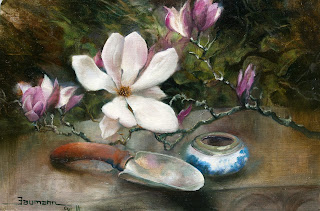Connecting with Your Art

Connecting with Your Art
With all the rain we have had in Mt. Shasta, I wanted to paint something with a bit more color. A really good friend found this tulip tree branch. I really enjoyed painting it.
There is a difference between painting with intention (to do something with an agenda) and connecting with your painting.
Artists are painting with an agenda when they try to create a painting that looks like a photograph or a subject from life. Connecting with your painting involves painting what you know - your reality, your life, and how you see the world daily.
Artists paint by placing strokes of color on their canvas to recreate the subject they have chosen to paint. Then, there comes a moment when the focus shifts and the image becomes three-dimensional. This is when we are connecting with our art. It only happens when the right side of the brain relies on what it knows and rather than how to do to it.
Try an experiment. Paint an image of one of your toys that you had growing up. Paint it from your memory. Try looking at the painting while you are painting as if you are seeing the toy again, but then look at if as if you have never seen it before. Don’t ask how, just do it as if you know how. Keep looking at the painting and making changes - see the light on it, see the shadows. Before long, you will see it as real as if you are looking at the real object or a photo of it.
The human brain is very complex and cooperative. It will think of what you tell it to think about such as your experiences, feelings and images as long as you have them stored in your memory already. If you want to paint landscapes, you must spend lots of time painting from nature, storing many images and experiences for the brain to access. Painting outdoors allows you to become observant of what only you can see through your eyes. The reason we paint out doors is not to come home with a completed painting. It is to educate your mind to see what nature looks like so that when you are in the studio, your auto-recall can go into high gear and you can connect with your painting like never before. This is what athletes call “being in the zone”
If you want to learn more about this subject, stayed tuned.
If you want to have an opportunity to paint outdoors and experience how you can fill your brain with images, feelings, and observations of nature, I invite you to come to my workshop in Mt Shasta on June 17-18-19. There is space for a few more participants. If you are interested, go to my website at thegrandview.com to learn more and to register.







